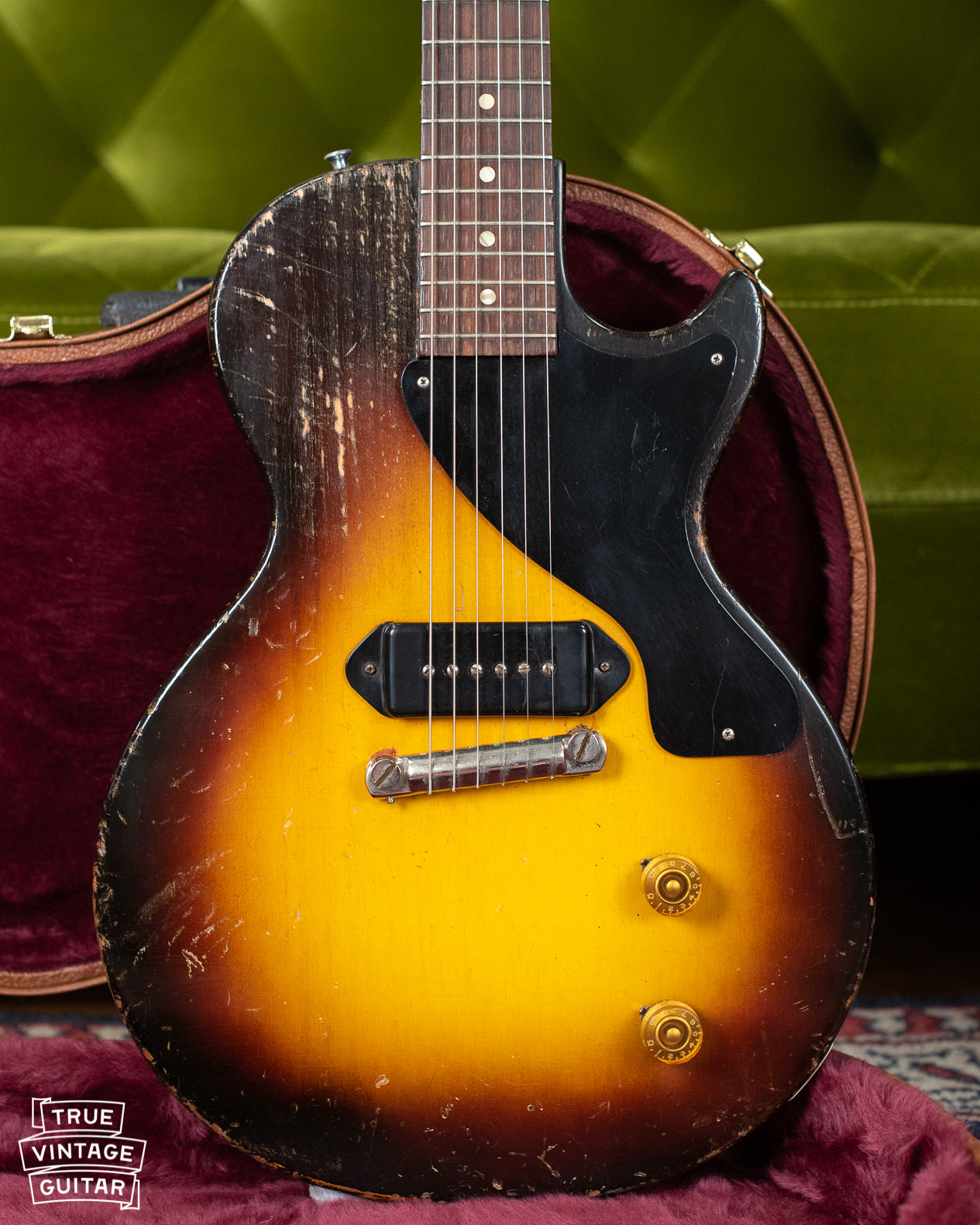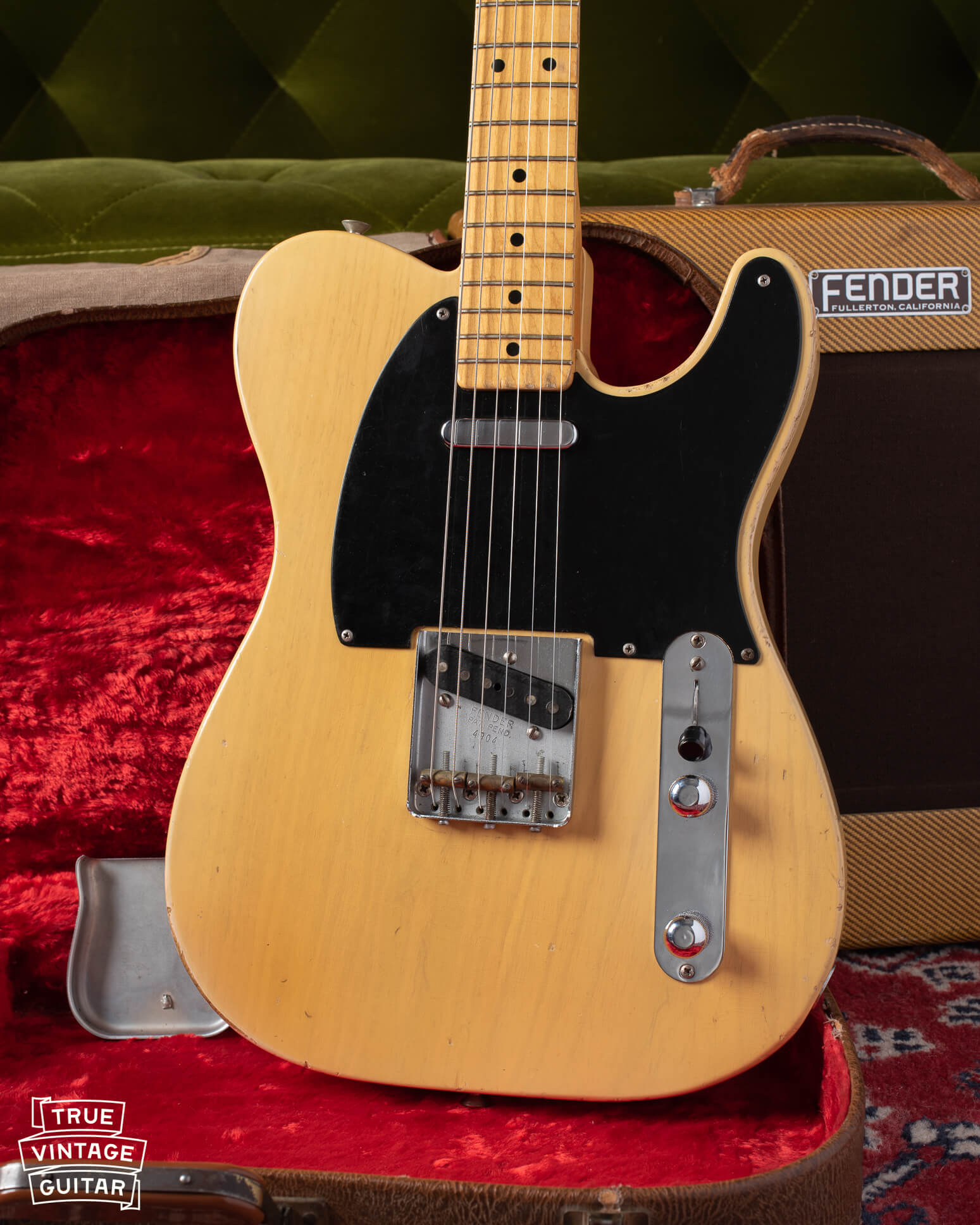The Fender Telecaster has been in continuous production since its introduction as the Broadcaster in 1950, so how do collectors find out the year it was made and its value? Telecaster values range wildly depending on what year they were made, so accurate dating and identification is a very important step in finding out how much they're worth. Fender guitar collectors can date a Telecaster with only a quick glance, but the most accurate way to date them is through a thorough inspection.
As a passionate vintage Fender guitar collector, I want you to know how to find the year and value of your Fender Telecaster so you can feel confident to sell your guitar. If you're interested in selling a vintage Telecaster to a qualified buyer for a fair price then contact me here: Sell a Fender. You can contact me here to have a Fender guitar expert Appraisal for your Telecaster. I'd be happy to help with how to find the year and value of your Telecaster.
If you're looking for more information on vintage Fender Telecaster guitars then I recommend this book: The Fender Telecaster by Andre Duchossoir. It's a great resource for all the small details of how the Fender Telecaster changed throughout the years.
How to date Fender Telecaster guitars from the 1950s and 1960s
How much is a vintage Fender Telecaster worth? Find the value
Telecaster timeline from the introduction as the Broadcaster in 1950 throughout the 1950s and 1960s

How to date a Telecaster
This section details how to date your Fender Telecaster in two ways: by serial number and by interior date codes. This works best for guitars that have all their original parts, but it may still be helpful if your guitar has been modified.
Find the Year of your Telecaster by Serial Number
The simplest way to date your Fender Telecaster is to read the serial number. The serial number on a Telecaster can be located in one of five places: the bridge plate, the neck plate, the front of the headstock, the back of the headstock, or neck heel. While this is a quick way to date a Telecaster, it's not the most accurate since the numbers aren't necessarily sequential. Use the graphic below to find the location of the serial number on your Telecaster:

Once you've located the serial number on your Telecaster, you can use our Fender Serial Numbers page to instantly identify the year that the serial number indicates. However, the serial number alone can't always identify the exact year it was made. Fender serial numbers aren't necessarily consecutive and they're typically on a part that can easily be replaced. They're simply the first and easiest way to begin the process of finding out what year it was made.

This graphic shows four different Telecaster serial number styles used from 1950 until 1976. When the Telecaster shaped guitar debuted in 1950 as the Esquire then the Broadcaster, the serial numbers were assigned to the bridge plate. Fender began reissuing guitars with serial numbers on the bridge plate in the 1980s, but they typically have an A or V prefix and/or have 5 digits. By 1954, the serial numbers moved to the neck plate with no letter prefix. By 1963, an "L" prefix was added to the beginning of the serial number which started over at "L00001". Fender updated the style again in late 1965 to the "F" logo plate consisting of 6 digits beginning with 100001. I buy Fender Telecaster guitars from the 1950s and 1960s: Sell a Fender.
Date your Telecaster by Interior Date Codes
If the serial number alone isn't enough to identify the year it was made, you can also use the interior date codes. You can often find interior dates in the following places: neck heel, bridge pickup cavity, and potentiometer codes.
Fender Telecaster Neck Heel Dates
Most Telecasters will have a date code on the heel of the neck which is only seen when the neck is removed from the body. We recommend leaving this process to a professional since it's a more involved process and risks damaging the guitar. Here is what the neck heel date codes look like from the 1950s until the 1970s:

|
Years: |
Neck heel date style: |
| 1950 - 1957 | Initials "TG" or "XA". Month - Day - Year |
| 1957 - 1962 | Month - Year. Some without dates 1959 & 1960 |
| 1963 - 1969 | Model code, Month, Year, Neck code |
| 1969 - 1971 | Model code, batch number, Year digit, 2 week digits |
The neck heel date code is typically a bit earlier than the rest of the guitar since the dates were applied when the neck was roughed out, not when the guitar shipped from Fender. The neck heel date codes are typically the earliest date of the manufacture. The neck heel date should be within about 6 months of the potentiometer code or pickup dates. If the neck heel is a year or more apart from the rest of the dates or the serial number, then there's a good chance that the guitar has been modified.
Date a Telecaster by Potentiometer codes
Since both the serial number and neck heel indicate the same year, we can then check to see if the potentiometers support the year as well. Potentiometers are variable resistors that allow a player to control the volume and tone of the guitar's signal going to the amplifier. They have codes on them which indicate the manufacturer, year, and week of the year. The potentiometer codes on this Telecaster read: "304704" where 304 = Stackpole (manufacturer), 7 = 1957, and 04 = the 4th week of the year.

How Much Is A Telecaster Worth?
Now that we know what year the Fender Telecaster was made, we can begin to compare our guitar with other guitars that are currently available for sale. When I'm comparing Telecasters, I look for guitars from the same year, condition, originality, and color. Since Fender generally increased production year over year, there are far fewer earlier guitars than there are later guitars. This is why we would compare Telecasters made during the same year or time period to find out how much they're worth. You can contact me here if you're curious about what a Fender guitar collector might pay for your vintage Fender Telecaster: Fender Guitar Buyer.
A Fender Telecaster made between 1952 and 1965 can be worth $10,000 to $100,000. Get help with value here: Contact Me.
The condition is another very important factor in finding the value of a Fender Telecaster. Fender guitar collectors will usually prioritize a clean and unworn Telecaster over a similar guitar with loads of player wear and grime. We don't mind a little wear and tear, but I personally enjoy the feel of unworn original frets when I'm playing my Telecasters. I still enjoy a well worn vintage Tele, but I usually have to have them refretted or repaired in other ways to get them to play as they were intended. There are far fewer unworn 1950s Telecasters than there are Telecasters that have been played.
Original parts are another important factor impacting Telecaster values. The finish is likely the most important part of a vintage Telecaster. It was very common for people to refinish Fender guitars since they're easily disassembled using only a screw driver. It's also common to find replaced pickups, potentiometers, and wiring in vintage Telecasters. Fender guitar collectors will always prioritize guitars original parts over guitars with many replaced parts.
The Fender Telecaster was offered in the standard finish it called Blond which is also the most common finish. A Blond finish is a semi-translucent cream white color with wood grain visible through it. Any finish other than Blond is considered a custom color, and Fender guitar collectors will prioritize custom colors over the standard Blond finish. I am always looking for custom color Fender Telecaster guitars. Please contact me if you have a black, blue, red, or sunburst Telecaster from the 1950s or 1960s.

1950s Fender Telecaster Timeline
Leo Fender's Telecaster wasn't the first solid body electric guitar, but it was the first mass produced and widely adopted solid body electric for spanish style playing. Here is a basic timeline of how the model changed throughout the years. I am looking for the nicest examples of Esquire, Broadcaster, and Telecaster guitars. You can contact me here if you're looking to sell a Fender.

The Telecaster's "Black Guard" Era: 1950 - 1954
Guitar collectors refer to the Telecasters made from 1950 until 1954 as "Blackguard Teles" in reference to the black phenolic pickguard.
1949: Leo Fender experiments with the solid body guitar which would become known as the Esquire with either one pickup or dual pickup. Pre-production samples were made in black with white pickguard, white, and Blonde with black pickguard.
1950: The first guitars go into production as the Esquire with no truss rod. By October of 1950, the name "Broadcaster" is used for the two pickup guitars which now feature a truss rod standard. The two pickup guitars include a blend knob to vary the amount of signal from each pickup.
1951: The Broadcaster name is dropped after a cease and desist letter from Fred Gretsch over his Broadkaster drum line. The remaining Broadcaster headstock labels have the model name clipped leading to the nickname "Nocaster" by collectors in later years. The new Telecaster model name logos were in use by the end of the year. Contact me if you have one you'd like to sell: Sell Fender.
1952: The Telecaster production is in full swing. The original thremometer shaped case is updated to the flat side form fit case. The blend knob wiring is updated to instead have a tone knob with no "both on" switch position. The both pickups on switch position doesn't exist until 1967. Contact me if you have one you'd like to sell: Sell Fender.
1953: The Telecaster is a commercial success; production increases. Leo is experimenting with a new model which would become the Stratocaster. Example here: 1953 Fender Telecaster.
1954: The classic butterscotch blond finish with thick black pickguard aesthetic is updated to a whiter blond finish and the black guard replaced with a single ply white pickguard. The brass bridge saddles changed to smooth steel saddles. The tweed center pocket case replaces the brown form fit case.
The Telecaster's White Guard/Maple Neck Era: 1954 - 1959
The Telecaster model is updated to feature a bright white single ply pickguard in 1954. The one piece Maple neck and fretboard is standard until the Spring of 1959.
1955: Staggered pole pieces are introduced on the Telecaster's bridge pickup. The large rounded neck profile transitions to a V shape with thinner shoulders. The tweed center pocket case was updated to a bass side pocket like later cases.
1956: On very rare occasions, custom color finishes could be ordered at a 5% upcharge. Real original custom color Fender guitars from the 1950s are extremely rare and valuable. The standard Telecaster model changed little, but among the changes is the switch from the round button string tree to the butterfly shape. This is a great example of a 1956 Fender Telecaster.
1957: Telecaster necks remain V shaped but gradually transition back to round C or U shape. Example here: 1957 Fender Telecaster.
1958: The smooth steel saddles are updated to a threaded style. The bridge plate gains six holes on the back to thread the strings through instead of the ferules on the back of the body (called top loader bridge by collectors).
The Telecaster's "Slab Board" Era: 1959 - 1962
The Telecaster's one piece Maple neck is updated to feature a thick slab Rosewood fretboard in the spring of 1959. The slab board is standard until the introduction of the veneer style in the summer of 1962.
1959: A thick Rosewood fretboard replaces the one piece Maple neck and lacquered board. Fender reverts back to the old style string through the body as a result of the unpopularity of the top loading bridge.
Fender introduced a fancy new version in June of 1959 with Sunburst finish and double white plastic bound body called the Telecaster Custom. Here's a rare example from the first production batch: 1959 Fender Telecaster Custom
1960: Not much changes for the 1960 model year, but Fender did update the look of the case from the tweed covering to the new brown Tolex covering. Check out this example: 1960 Fender Telecaster Olympic White.
1961: The "Telecaster" peghead decal gains two patent numbers underneath the logo.
1962: The thick slab Rosewood fretboard lasts until the Summer of 1962. A slightly thinner veneer Rosewood fretboard is now standard.
The Pre-CBS Veneer Board Telecaster: 1963 - 1965
The short lived slab Roswood fretboard is updated to the slightly thinner veneer style fretboard during the summer of 1962.



